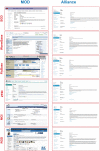Harmonizing model organism data in the Alliance of Genome Resources
- PMID: 35380658
- PMCID: PMC8982023
- DOI: 10.1093/genetics/iyac022
Harmonizing model organism data in the Alliance of Genome Resources
Abstract
The Alliance of Genome Resources (the Alliance) is a combined effort of 7 knowledgebase projects: Saccharomyces Genome Database, WormBase, FlyBase, Mouse Genome Database, the Zebrafish Information Network, Rat Genome Database, and the Gene Ontology Resource. The Alliance seeks to provide several benefits: better service to the various communities served by these projects; a harmonized view of data for all biomedical researchers, bioinformaticians, clinicians, and students; and a more sustainable infrastructure. The Alliance has harmonized cross-organism data to provide useful comparative views of gene function, gene expression, and human disease relevance. The basis of the comparative views is shared calls of orthology relationships and the use of common ontologies. The key types of data are alleles and variants, gene function based on gene ontology annotations, phenotypes, association to human disease, gene expression, protein-protein and genetic interactions, and participation in pathways. The information is presented on uniform gene pages that allow facile summarization of information about each gene in each of the 7 organisms covered (budding yeast, roundworm Caenorhabditis elegans, fruit fly, house mouse, zebrafish, brown rat, and human). The harmonized knowledge is freely available on the alliancegenome.org portal, as downloadable files, and by APIs. We expect other existing and emerging knowledge bases to join in the effort to provide the union of useful data and features that each knowledge base currently provides.
Keywords: biocuration; data mining; gene expression; gene function; gene interaction; genome; knowledgebase; phenotype; variants.
© The Author(s) 2022. Published by Oxford University Press on behalf of Genetics Society of America.
Figures








References
Publication types
MeSH terms
Grants and funding
- U24 HG000330/HG/NHGRI NIH HHS/United States
- U24 HG002659/HG/NHGRI NIH HHS/United States
- U41 HG002273/HG/NHGRI NIH HHS/United States
- U24 HG010859/HG/NHGRI NIH HHS/United States
- MR/L001020/1/MRC_/Medical Research Council/United Kingdom
- U24 HG012212/HG/NHGRI NIH HHS/United States
- U24 HG001315/HG/NHGRI NIH HHS/United States
- WT_/Wellcome Trust/United Kingdom
- U24 HG002223/HG/NHGRI NIH HHS/United States
- R01 HL064541/HL/NHLBI NIH HHS/United States
- U41 HG000739/HG/NHGRI NIH HHS/United States
- R01 LM013871/LM/NLM NIH HHS/United States
- MR/N030117/1/MRC_/Medical Research Council/United Kingdom
- U24HG002659/HG/NHGRI NIH HHS/United States
- P41 HD062499/HD/NICHD NIH HHS/United States
LinkOut - more resources
Full Text Sources
Molecular Biology Databases
Miscellaneous

